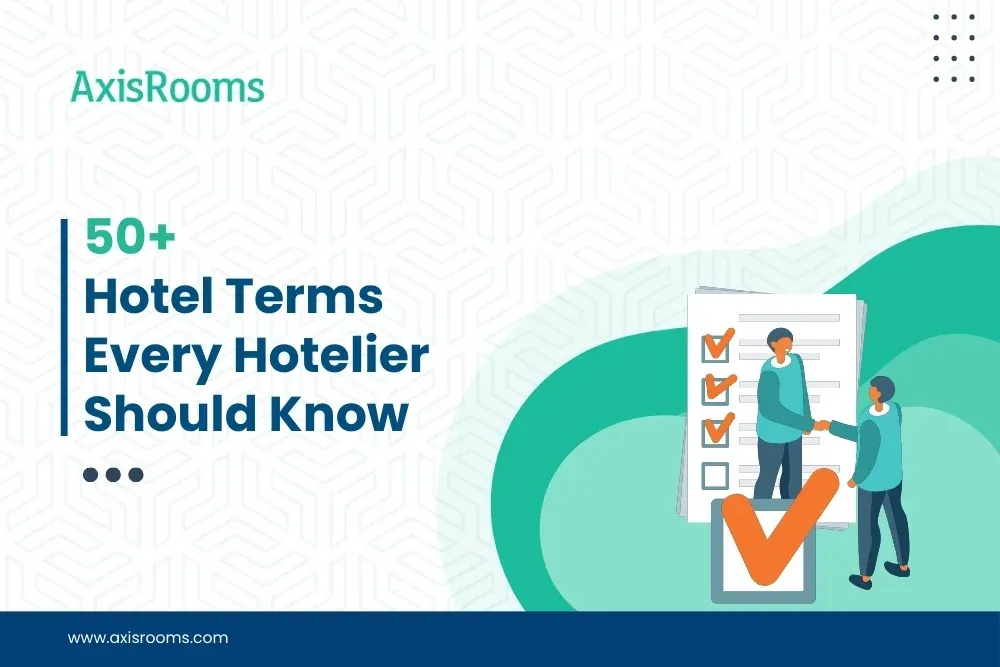Introduction: Why Hotel Terminology Matters
Hospitality professionals often encounter industry-specific terms in daily hotel operations. Whether you're a property owner, revenue manager, or front desk agent, understanding these terminologies improves communication, enhances decision-making, and helps you better manage your hotel’s performance.
Below is a detailed glossary of 50+ commonly used hotel terms, written in full sentences for clarity and practical understanding.
50+ Hotel Terms Every Hotelier Should Know
50+ Most-Used Hotel Terms Explained
1. ADR (Average Daily Rate)
The Average Daily Rate represents the average income earned from occupied rooms in a day. It is calculated by dividing the total room revenue by the number of rooms sold.
2. RevPAR (Revenue Per Available Room)
Revenue Per Available Room shows how much revenue a hotel generates for each available room, regardless of whether the room is occupied or not. It is calculated by multiplying the ADR by the occupancy rate.
3. ARPAR (Adjusted Revenue Per Available Room)
ARPAR refines the RevPAR calculation by subtracting variable costs, offering a more accurate reflection of profitability per available room.
4. ALOS (Average Length of Stay)
This metric measures how long guests typically stay at a property. It is calculated by dividing the total number of room nights sold by the number of individual bookings.
5. APR (Average Published Rate)
The Average Published Rate is the average rate offered for all room types over a period of time, regardless of whether it is peak or off-season.
6. AGR (Average Rate per Guest)
This term refers to the average revenue generated per guest. It is determined by dividing total room revenue by the number of guests who stayed during the period.
7. BAR (Best Available Rate)
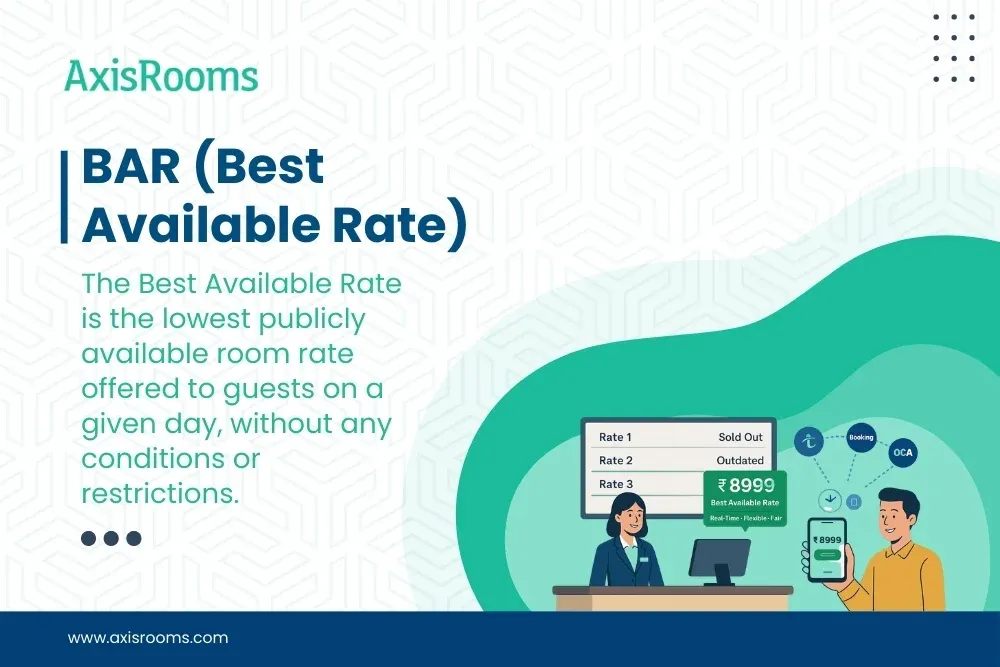
The Best Available Rate is the lowest publicly available room rate offered to guests on a given day, without any conditions or restrictions.
8. BEO (Banquet Event Order)
A Banquet Event Order is a formal document outlining every detail of an event being hosted at the hotel, including setup, catering, timing, and special requests. It serves as a reference for hotel staff and clients.
9. Booking Engine
A booking engine is an online tool that allows guests to make reservations directly through a hotel’s website. It typically displays real-time availability and rates, and processes secure payments.
10. Booking Pace
Booking pace refers to the speed at which reservations are made for a specific future date. It helps hoteliers forecast occupancy and plan pricing strategies.
11. Booking Window
The booking window is the period between when a guest makes a reservation and their check-in date. A longer window allows for better forecasting and often lower rates.
12. Bucket Check
A bucket check is a process where hotel staff verifies all guest bookings, room assignments, and folio charges against the property management system to ensure accuracy.
13. Channel Manager
A channel manager is a software tool that connects your hotel’s inventory to multiple OTAs and ensures rates, availability, and bookings are synchronized across all platforms.
14. CRS (Central Reservation System)
A Central Reservation System is used by hotels to manage and distribute inventory and rates to various booking channels, such as websites, OTAs, and call centers.
15. CRO (Central Reservation Office)
A Central Reservation Office is the team or department that manages reservation requests received through phone calls, emails, or brand websites, especially in hotel chains.
16. Cut-off Date
The cut-off date is the final day by which a group must confirm or cancel their room block without incurring penalties or rate changes.
17. CPOR (Cost Per Occupied Room)
Cost Per Occupied Room is the average operational cost associated with servicing an occupied room. It includes housekeeping, utilities, and room supplies.
18. COW (Cost of Walk)
Cost of Walk is the cost incurred when a hotel has to relocate an overbooked guest to another property. This includes transportation, room charges, and possibly vouchers or compensation.
19. Continental Plan (CP)
The Continental Plan is a pricing structure that includes the room rate and a complimentary breakfast. It is commonly used in both business and leisure hotels.
20. Distressed Inventory
Distressed inventory refers to unsold rooms that are at risk of being unbooked as the stay date nears. These are often sold at discounted rates to generate last-minute revenue.
21. Double Booking
Double booking occurs when two reservations are made for the same room on the same date, usually due to system errors or poor synchronization across channels.
22. Dynamic Pricing
Dynamic pricing is a strategy where room rates are adjusted in real-time based on demand, market trends, local events, and competitor pricing.
23. Displacement Analysis
Displacement analysis is the process of comparing the potential revenue from different booking types, such as group vs transient, to make the most profitable booking decision.
24. Derived Rates
Derived rates are automatically adjusted rates based on a parent rate. For example, a corporate rate may always be 10% less than the BAR.
25. European Plan (EP)
The European Plan includes only the room rate, with no meals provided. Guests pay separately for any additional services.
26. Early Bird Discount
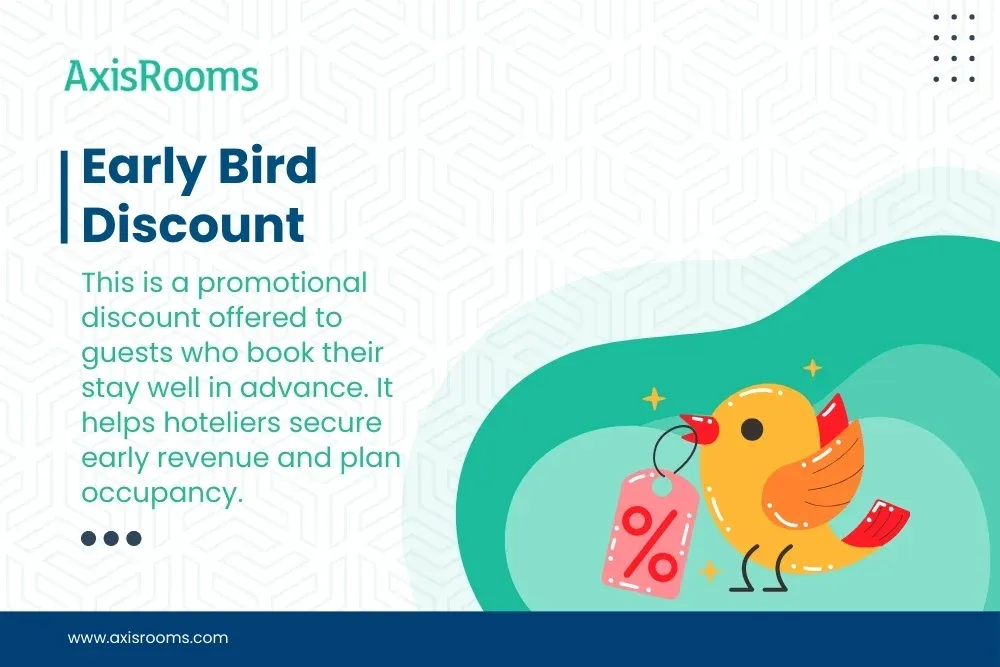
This is a promotional discount offered to guests who book their stay well in advance. It helps hoteliers secure early revenue and plan occupancy.
27. Fenced Rate
A fenced rate is a discounted rate offered with restrictions, such as no cancellation or prepayment required. These rates help hotels fill rooms with committed guests.
28. FPLOS (Full Pattern Length of Stay)
Full Pattern Length of Stay is a tool that helps hoteliers accept bookings based on how well the guest’s length of stay aligns with maximizing occupancy and revenue.
29. GOPPAR (Gross Operating Profit Per Available Room)
This metric shows the gross operating profit earned per available room, calculated by subtracting operating expenses from revenue, then dividing by the number of rooms.
30. Group Wash
Group wash is the difference between the number of rooms initially reserved by a group and the actual number used. It helps in better forecasting and inventory control.
31. LRV (Last Room Value)
Last Room Value refers to the maximum amount of revenue a hotel can expect to earn from its last remaining room for a given date.
32. LOS (Length of Stay)
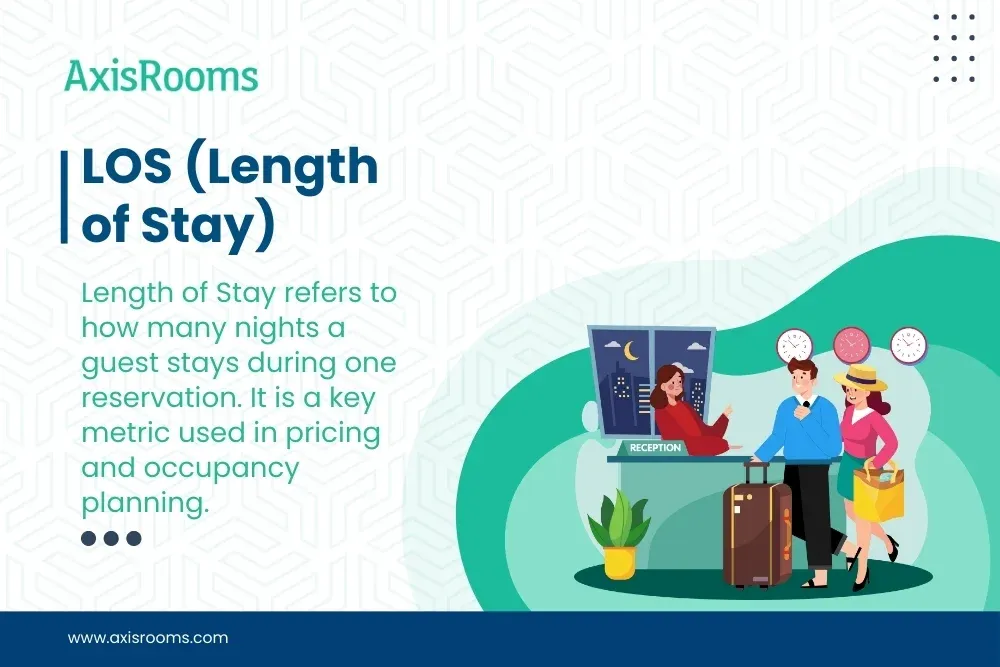
Length of Stay refers to how many nights a guest stays during one reservation. It is a key metric used in pricing and occupancy planning.
33. Min/Max LOS
These are restrictions placed by the hotel that define the minimum or maximum number of nights a guest can book during a certain period.
34. MAR (Minimum Acceptable Rate)
The Minimum Acceptable Rate is the lowest rate a hotel is willing to accept for a group or corporate booking to ensure profitability.
35. MICE (Meetings, Incentives, Conferences, and Exhibitions)
MICE refers to the business travel segment where large-scale events and gatherings are held at hotel venues, generating revenue through rooms, event spaces, and services.
36. Metasearch Engine
A metasearch engine aggregates hotel rates and availability from different OTAs and brand websites, allowing users to compare prices on platforms like Google Hotels or Trivago.
37. MAP (Modified American Plan)
This plan includes a room, breakfast, and either lunch or dinner. It’s popular among travelers looking for convenience and cost predictability.
38. No-Show
A no-show happens when a guest does not check in for a reservation and fails to cancel. Hotels may charge a fee to compensate for lost revenue.
39. Night Audit
Night audit is a daily process performed by the front desk team to close the business day, reconcile transactions, and ensure all charges and revenues are correctly posted.
40. Net Rate
Net rate is the discounted room rate provided to wholesalers or travel agents, who then add their markup before selling to end customers.
41. Negotiated Rate
A negotiated rate is a pre-agreed room rate between the hotel and a corporate or long-term partner for consistent business.
42. Occupancy Rate
This metric shows the percentage of available rooms that are occupied during a specific period. It is calculated by dividing rooms sold by total rooms available.
43. Occupancy Forecast
An occupancy forecast is a forward-looking estimate of how many rooms are expected to be sold in the coming days, weeks, or months.
44. Overbooking
Overbooking is the practice of accepting more bookings than available rooms, anticipating that some guests will cancel or not show up.
45. Online Reputation Management
This involves monitoring, responding to, and managing guest reviews across online platforms to build trust and improve your hotel’s brand image.
46. OTA (Online Travel Agency)
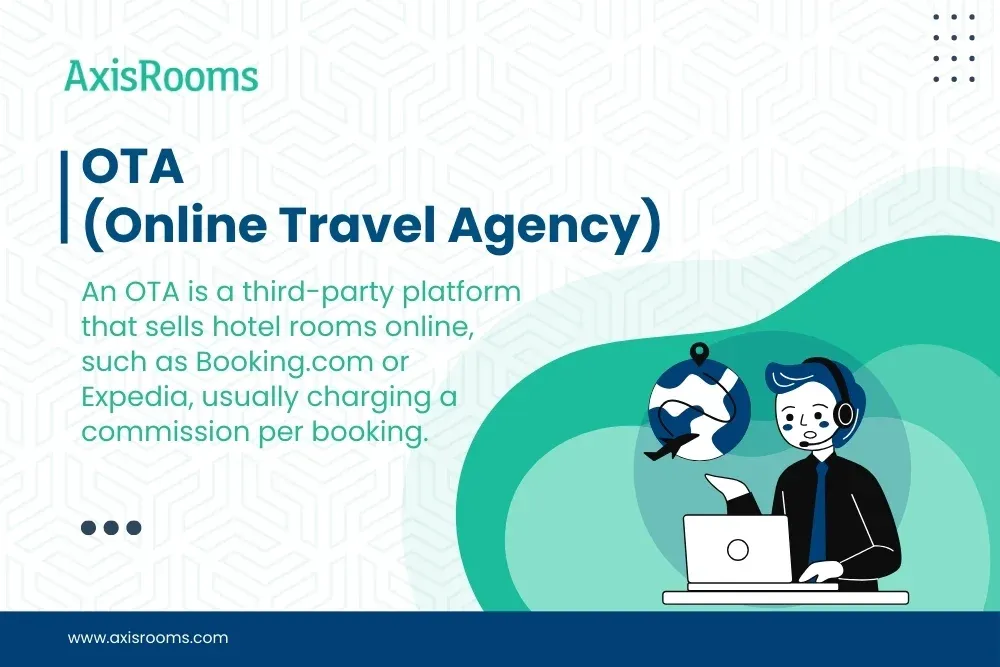
An OTA is a third-party platform that sells hotel rooms online, such as Booking.com or Expedia, usually charging a commission per booking.
47. PMS (Property Management System)
A PMS is core hotel software used to manage bookings, check-ins, check-outs, housekeeping, billing, guest preferences, and reporting.
48. Pre-payment Guarantee
A pre-payment guarantee means the guest pays in full before arrival, ensuring commitment and reducing the chance of cancellations.
49. Rack Rate
The rack rate is the full, published room rate before any discounts or promotions are applied.
50. Rate Shopper
Rate shopper tools allow hotels to monitor competitors’ pricing in real-time, helping them adjust their own rates strategically.
51. Seasonal Rates
These are room rates that change depending on demand trends—typically higher during peak travel seasons and lower during off-peak periods.
52. STR Report
This is an industry-standard report that benchmarks a hotel’s performance—like occupancy and RevPAR—against its competitors in the same market.
53. TrevPAR (Total Revenue Per Available Room)
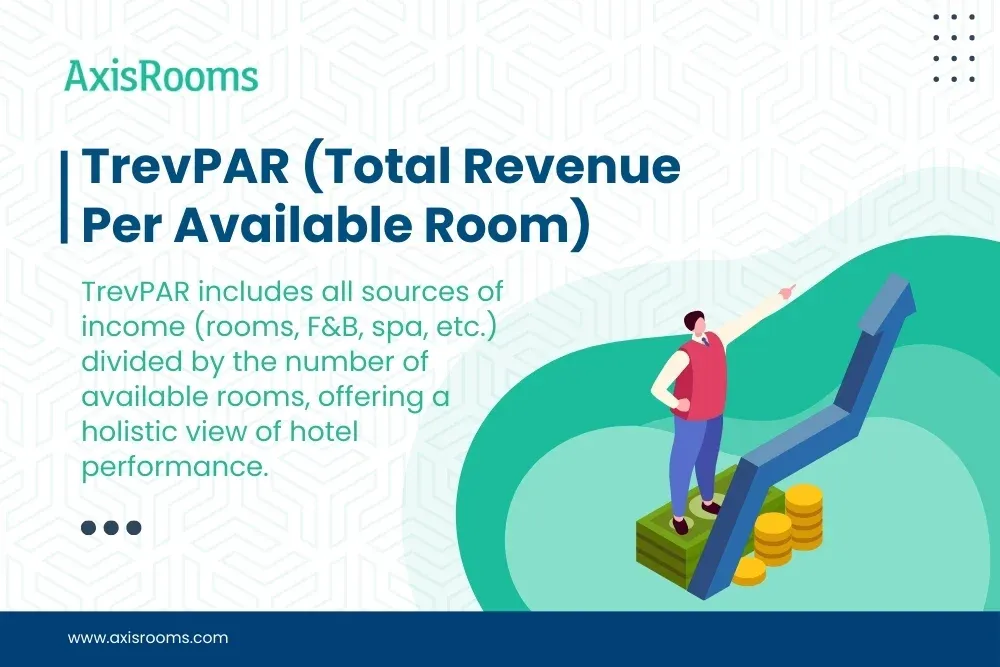
TrevPAR includes all sources of income (rooms, F&B, spa, etc.) divided by the number of available rooms, offering a holistic view of hotel performance.
54. True Demand
True demand refers to the total number of rooms a hotel could sell without any restrictions like rate limits or capacity constraints.
55. Under booking
Under booking happens when the hotel has more vacant rooms than expected, often leading to missed revenue opportunities.
56. Yield Management
Yield management is a dynamic pricing strategy used to maximize revenue by selling the right room to the right guest at the right price and time.
57. Zero Out
Zero out is the process of settling all guest charges, ensuring the folio balance is cleared at the time of check-out.
AxisRooms: Where Terminology Meets Distribution Technology
With 30% of hotel bookings happening last-minute, it's quite evident that having visibility into distressed inventory is crucial. AxisRooms' Rate Shopper allows you to monitor competitors' pricing in real-time, helping you position your rates strategically to maximize both occupancy and revenue. The Revenue Management as a Service option takes this further by providing expert guidance on pricing strategies—turning complex metrics like RevPAR and ADR into actionable revenue opportunities.
Don't waste empty rooms or get lost in a maze of extranet logins. Get practical. A modern Channel Manager goes beyond mere terminology—it's the strategic tool that transforms industry jargon into tangible bookings and optimized revenue for your property.
Conclusion: Speak the Language of Smart Hoteliering
Mastering hotel terminology isn’t just about sounding industry-savvy—it’s about making smarter decisions, streamlining operations, and boosting profitability.
Whether you're managing a single property or scaling a hotel group, knowing these terms empowers you to work more efficiently and align with best practices. And with tools like AxisRooms PMS, you’re equipped to put this knowledge into action—seamlessly and strategically.

